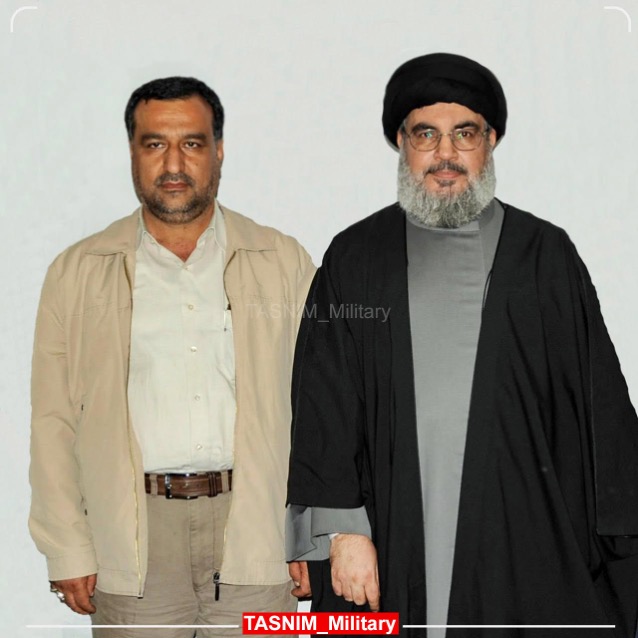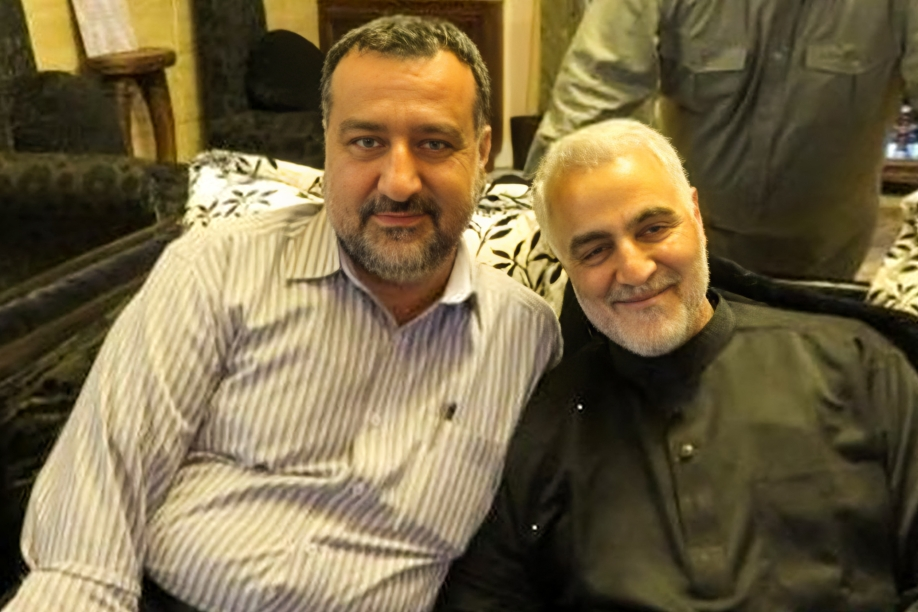

Photo: Mousavi, left, and Secretary-General of Hezbollah Hassan Nasrallah, right. (Tasnim Military)
While Israel has frequently targeted Iran-affiliated militias, Hezbollah members and infrastructure in Syria, including Iranian ammunition and weapons depots as part of the Israeli army’s published strategy Campaign Between the Wars (CBW), the operation on December 25, 2023 is particularly remarkable. This operation specifically targeted Razi Mousavi, a prominent Iranian commander, marking a significant development in the ongoing conflict between Israel and Iran in Syria. The incident is also significant because of the tensions escalating on several fronts in the region following Hamas’ attack on Israel on October 7, 2023. This report analyzes the motives behind Israel’s targeting of Mousavi and its significance in the conflict between Iran and Israel in Syria.
Razi Mousavi: Assigned Tasks and Role in Iran’s Strategy in Syria
Razi Mousavi was a prominent commander in Iran’s Revolutionary Guards Corps (IRGC) and was reportedly sent to Syria as a military advisor coordinating the military alliance between Syria and Iran. However, Mousavi’s role extended beyond advisory duties. He was a pivotal figure in Iran’s regional activities and was the right hand of former Quds Force commander Qassem Soleimani’s military operations.
Mousavi was the most senior commander in the IRGC’s Quds Force in Syria, serving as the head of Unit 2250. This unit, a subsidiary of Unit 2000, was established with the objective of facilitating the transfer of equipment, weapons and personnel from Iran to Lebanon via Syria. Mousavi’s extensive experience, spanning 30 years in Syria according to some reports, positioned him as the de facto commander of the Quds Force in Syria, particularly given Qaani’s limited popularity and experience in Syria. Therefore, it is understandable why Mousavi was a key target for Israel. The objective was to disrupt the logistical and weapons corridor linking Iran’s IRGC with militias in Syria and Hezbollah in Lebanon. This corridor poses a significant threat to Israel’s interests, especially considering the heightened tensions sparked by Hamas in October.

Photo: Sayyed Reza Mousavi, left, with Qassem Soleimani (Arab News citing from Tasnim News/AFP file)
Israel’s Motives and Messages Behind the Targeting
The Israeli airstrike near Damascus, which targeted Mousavi, was seemingly driven by geopolitical motives. These motives are closely tied to the quickly unfolding developments in the region. The operation was also apparently intended to send specific messages to Iran, which is the focus of the following part.
Sending Military Messages to Iran
Mousavi had long been a target for Israel, with Israel’s attacks on Unit 2250 not being a new development. This unit had already experienced an attack back in September 2022. To get Mousavi, Israel had intensified its strikes on Syrian airports and other strategic locations in southern Damascus. Various Israeli operations in Syria resulted in the killing of several Iranian commanders, including Mohammad Hejazi, deputy commander of the Quds Force in 2021. Furthermore, the IRGC had disclosed in early December that an Israeli attack in Syria claimed the lives of two of its commanders without providing further details about these individuals.
These Israeli operations conveyed some military messages. These included disrupting Iran’s increasing use of air routes to deliver weapons to its allied militias in Syria and Lebanon, including Hezbollah. Furthermore, the attacks signaled to Tehran that its IRGC members in Syria were under heightened Israeli scrutiny. Tel Aviv also attempted, against the backdrop of the events unfolding on the Lebanon-Israel border, to send warning messages to Hezbollah. The situation is becoming increasingly tense as Hezbollah’s responses intensify, raising concerns about a potential descent into an all-out war.
Sending Security and Intelligence Messages to Iran
The incident can also be interpreted from the perspective of the targeted location. The town of Sayyida Zeinab is vital for the Quds Force following the 2011 revolution against Syrian President Bashar al-Assad. It is home to thousands of Iran-led forces; thus, Israel targeted this area, striking at the heart of Iran’s influence in Syria.
The Israeli raid that targeted an Iranian commander of this magnitude in a town that is purely under Iranian control is unlikely to be arbitrary. In addition to its aim of striking at the core of Iranian influence, the Israeli government sent another indirect message. This message was intended to demonstrate its intelligence capabilities and precision in targeting the exact locations of Iranian leaders.
The targeting of Mousavi raises many questions and doubts within Iran regarding Tel Aviv’s capability to track the movements of its leaders in Syria as well as the sources of its information regarding Mousavi’s presence at a specific time and location. Could this be indicative of a security breach within Iran, given the instances of security and intelligence infiltrations that Tehran had experienced in recent years? Or could it be a result of Israel-Russia collaboration? This is a valid question, especially considering Iran’s longstanding skepticism about Russia’s silence on the hundreds of raids conducted by Israeli forces on Iranian locations and militias in Syria, including over 30 raids since October 7, 2023, all without any Russian condemnation.
It is noteworthy that in recent days, relations between Iran and Russia have been strained due to several issues. One of these is the apparent alignment between Russian and Arab positions on the current Palestinian-Israeli crisis. Russia’s support for Arab initiatives to resolve the ongoing crisis is opposed by Iran. Adding to this is Russia’s objection to Iran’s involvement in Arab domestic affairs, particularly in the three Emirati islands that Iran occupies.
Escalating Regional Tensions
Israel’s targeting of Mousavi cannot be analyzed without considering the several coinciding regional developments. These include the escalating tensions in southern Lebanon by Israel which have reached levels unseen since the outbreak of the October attack on Israel. It cannot also be viewed independently of the Israeli government’s attempts to deliver a strong blow to Hezbollah and forcefully change the status quo in its northern borders. This strategy is aimed at making Iran bear a portion of the cost of Hamas’s Operation Al-Aqsa Flood carried out on October 7, 2023. Moreover, the targeting of Mousavi is part of Israel’s pressure on Iran over contentious issues, such as the Iranian nuclear program.
Iran’s Position on the Attack and Potential Response Scenarios
Iranian officials were quick to express their unequivocal intent to hold Israel responsible for its attacks on their prominent leaders in Syria. Iranian President Ebrahim Raisi dubbed the assault on Mousavi as “malicious” and “another sign of Israel’s frustration and weakness in the region.” He threatened that Israel “will pay the cost of this crime.” Echoing this sentiment, the spokesperson for the Iranian Ministry of Defense, Brigadier General Reza Talaei, labeled the Israeli offensive on Mousavi as a “flagrant violation of Syria’s sovereignty,” pledging Iran will “powerfully” respond to this provocation.
The nature and timing of Iran’s response remains uncertain. However, the attack, at the heart of Iran’s power base, has undoubtedly caused local and regional embarrassment for Tehran, especially after decades of threats against Tel Aviv. The attack presents Iran with challenging decisions. Choosing not to respond could intensify the impact of the attack and encourage Tel Aviv to escalate its attacks and broaden its reach in the future, eventually establishing new rules for conflict with Tehran. Conversely, delivering a response could cause Iran to enter a situation it has been eager to avoid — engaging in the current conflict, or at the very least, bearing part of its cost.
The following scenarios could likely represent the Iranian response to the Israeli attack.
- – Direct response: Iran could directly target Israel. Although it is still a possibility, it is unlikely for Iran to pursue. This is because this response could lead the current conflict to spill out of control, drawing Iran into a direct conflict with Israel. Such a scenario is unfavorable for Iran at this point given its desire to preserve the gains it has accumulated over 13 years in Syria. The improbability of this scenario can be measured by several factors, including Iran’s military doctrine, military capabilities and the nature of its responses to previous attacks that took the lives of key Iranian military commanders and nuclear experts such as Qassem Soleimani and Mohsen Fakhrizadeh.
- – Proxy response: While an open confrontation with Israel is unlikely, Iran is expected to deliver a calculated and limited response. The Iranian response is likely to target Israeli interests in the region rather than key sites inside Israel. This will likely involve traditional approaches of military and security escalation or cyberattacks. These could include airspace breaches in the occupied Golan region south of Syria, targeting Israeli-owned ships in the Arabian Gulf and Arabian Sea — a strategy previously employed by Iran, or escalating attacks in Syria or in the Red Sea. A response from the southern front of Lebanon is also possible, although it is currently deemed unlikely. Other retaliations are likely to unfold such as cyberattacks or intelligence operations specifically targeting Israeli nationals abroad.
Conclusion
The targeting of Mousavi, the most influential Iranian commander in Syria, is considered a major escalation, on par with the US targeting of Soleimani. The event holds special importance given the unfolding regional developments that concern both Iran and Israel. It reflects an Israeli attempt to impose the cost of Hamas attacks on Iran and prevent Iran from capitalizing on the US and Israeli focus on the war in Gaza by strengthening its presence in Syria and Iraq. The Israeli operation also aimed to stop Iran from intensifying its nuclear activities and put an end to the provocations to its vessels in the Red Sea by the Iran-backed Houthis. It is possible that Israel undertook this high-stakes operation after realizing Iran’s reluctance to directly engage in the current conflict against Israel, a situation that could compel the United States to intervene.
Given the current heightened security and political tensions in the region, the targeting of Mousavi could escalate the level of risk. The security situation in Syria and Jordan has become tense following the thwarting of an arms smuggling attempt from Syria to Jordan, where Amman accused Iran-supported militias of being behind this unprecedented operation. Moreover, tensions in Lebanon and Iraq, coupled with the Houthi escalation in the Red Sea, all indicate the region’s drift toward a dangerous situation that its countries seek to avoid. This is in stark contrast to the efforts of Iran and Israel to fuel the conflict. The absence of a decisive US position on Israeli and Iranian actions further compounds the situation, potentially leading to an escalation in regional tensions.
